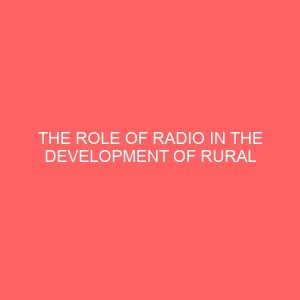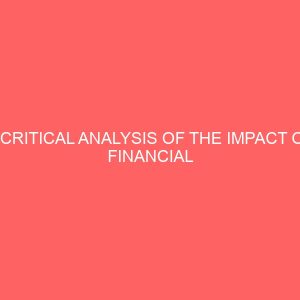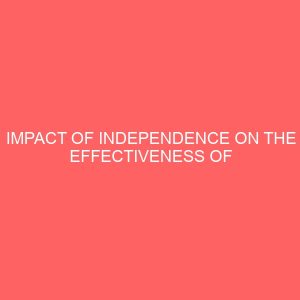Description
MICROFINANCE BANK AS A CATALYST FOR RURAL DEVELOPMENT
CHAPTER ONE
INTRODUCTION
1.1 BACKGROUND OF THE STUDY
Long before the inception of Microfinance banking system in Nigeria , intensive campaigns were organized nationwide urging community to form community Development Association [CDA] or where they already exist6 in form of town union or patriotic association to register them in their local government. This was to create an avenue for which they could more effect t lively participate in rural development programmes at grassroots .Development association was found and registered as at 31st December 1992.
It is pertinent to mention that government had before this time established some development agency intended to providing grassroots’ development. These include National Directorate for Employment [NDE] Better life programmed of Rural Dweller [BLPRD] Rural Banking ,people’s Bank and Directorate of food , road and Rural infrastructure [DEFRRI] whose primary task was to a identify , involve and support viable local community organization in the mobilization of the rural population for sustained rural development activities bearing in the mind the need of promoting greater participation and economic self- reliance on rural development “
On the basis of this and other functions defined in the Decree 4 of the 1987, as stressed by mabogunje, the directorate fell into three broad areas as
1. Community organization and social mobilization
2. Infrastructural Development
3. Promotion of productive activities.
The idea of Microfinance banking was made known to the public during January 1st 1990 budget speech by the president and commander of chief the Armed forces, General Ibrahhim Alamosa Babangida, in that speech he clearly spelt out what the government has in mind as follows.
The adjustment subsidy levels of domestic price of petroleum product have been estimated millions is 1990 fiscal year.
Government decided that the sum be put back into strengthening its programme of grass-root economic development.
Accordingly, the sun of N453 million will accrue to special account with the central bank to strengthening the people’s bank.
Maboguje defined Microfinance bank as a self sustaining financial institution, owned and managed by providing credit, deposit banking and other financial services to its members largely on the basis of their self recognition and credit worthiness”.
Based on the foregoing, microfinance banks are primarily set up to promote productive activities in the rural areas. Specifically, they ar5e meant to facilitate the programmes of the directorate of food, road rural infrastructure by providing easy access to credit for rural producers.
National Network of Microfinance banks are intended to greatly strengthen the massive programmes of government in rural development. To day’s over 1,110 Microfinance banks are found to have been established throughout the country with Alheri community Microfinance bank , Tudun Wada in Kadauna State as the first to be commissioned on 31st December, 1990.
The shift of emphasis to rural development is a matter of necessity at this present state of our development. It is important to state here that over 75% o the country’s resources endowment abounds in the rural areas. Again, part of our experiences in rural development has clearly shown of rural that effort at expanding economic base of scarcity of, and restricting access to loan able fund.
In addressing this problem, pervious government in their economic policies had relied exclusive on development banking and rural branch banking of the orthodox banks. However, it was observed that the sophisticated mode of operation of the conventional bank, their legalistic insistence on collateral had rendered them incapable of dealing with the unsophisticated rural dweller and lower strata of our society.
Jags and Nkom stressed that the introduction of Microfinance bank was itself motivated b y the failure of previous attempts at extending credit to the rural producer. It is therefore, in firm belief and commitment to rural development that every Nigerian who is engaged in productive activities must have access to loan able fund regardless of the size of loan. This is why Microfinance bank as a catalyst for rural development will be reviewed in the project between 2007 to 2012.
1.2 STATEMENT OF PROBLEM
Despite the various economic policies rural economic development, the
banking habit’s of rural dwellers have not improved appreciably banks are nearly operating exactly the same way as conventional banks do granting loans to small scale producers.
The bank require- collateral before credit is granted to rural dwellers and even the community development, as associations may not be able to afford it.
Besides these difficulties of Microfinance banks are for the rural dweller have the conception that banks are for the rich and elites of the society, owing to the fact that Microfinance banks have not recruited trained personnel that can disseminate proper banking in information to the rural populace.
In view of these, this study will address itself to the following problems.
[1] How can Microfinance bank make loan able funds accessible to rural borrowers to enhance economic activities?
[2] How will the loans provided serve urban Microfinance bank other than the demand for tangible security like collateral?
[3] How can the rural banking habit be improved by Microfinance bank in other to assist in rural development programmers?
1.3 OBJECTIVE OF THE STUDY
The main objective of this study lies on Microfinance bank as a catalyst for rural development in Enugu state in general and in particular; the role Microfinance bank can play in the rural development of areas.
In addition to the major objective, the study will also ascertain the following.
1. Whether the availability of tangible collateral have any position effect on the level of loans disbursement in the community.
2. Whether the awareness campaign organized by Microfinance bank have improved the banking habits of the people of the area.
3. Whether loans granted to rural dweller by Microfinance bank have any positive effect on the unemployment level of the community.
4. Whether Microfinance bank can accept self-recognition as alternative security to collateral in granting loans to the inhabitants of rural areas.
5. Whether the incidence of loan repayment default by rural dweller have any significant effect on the level of loans of Microfinance bank.
6. To recommend ways by which Microfinance bank services in the development of rural area could be sustained.
1.4 RESEARCH QUESTIONS
1. To what extent has the unavailability of tangible collateral affect the disbursement of loan in microfinance bank?
2. What is the effect of the loans granted to the inhabitants of rural dwellers unemployment in the community?
3. To what extent has the awareness campaign carried out to the rural dwellers in Enugu state?
4. To what extent has self recognition served as an alternative collateral
for granting loans to the inhabitants of rural dwellers?
5. To what extent has loans repayment default affected the level of loans granting by Microfinance bank to her customers?
6. What level of sustainability are needed services in the development of rural community?
1.5 RESEARCH HYPOHESIS
1 The unavailability of tangible collateral has not affected the level of loan disbursement to member of the rural community.
2 Ho the loan s made available by Microfinance bank to the rural dwellers
In the community has not reduced the level of unemployment in the area.
3 Hi the made available by Enugu Microfinance bank to the rural dwellers has reduced the level of unemployment in the area.
4 Hi the banking awareness campaign organized by Microfinance bank has not assisted significantly in enhancing the rural banking habits of the people in rural area.
Hi the banking awareness campaign organized by Enugu Microfinance bank has assisted significantly in enhancing the rural banking habits of the people in the rural area.
1.6 SIGNIFICANCE OF STUDY
This study shall benefit the under listed people and institution.
Research Students – it is the intention of the research to provide a stepping stone of success to other students and or researchers who may be conducting a research on the same or related topic in future. These materials will serve as a reference point to such person or persons.
Microfinance banks – It is equally hope that at the end of this research work, Microfinance banks will be provided with possible solution to the various reasons hindering the development of the rural areas. This work if properly studied will go a long way in ensuring the steady financial support form both Microfinance banks and other financial houses to the development of the rural areas.
Industrialists – The abundant advantage available to rural industrialist in sourcing their capital are enormous. It is indented to bring these merits into light so as to enable the rural industrialists utilize this avenue effectively so as to contribute successfully to the development of rural areas and the economy at large. It is also believed that this will create banking awareness so as to eliminate those obstacles facing then in their areas of settlement.
The economy – With other 75% of the country’s resources endowment abounds in the ru4al areas, our development project and programmes cannot achieve any appreciable improvement until they focus on the se rural area consequently this study will to a large extent, highlight the proper roles which Microfinance banks play in their area of operation .This will increase the economic activities in the rural economy, reduce unemployment and urban migration.








Reviews
There are no reviews yet.